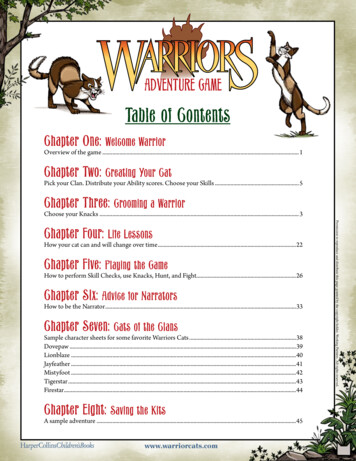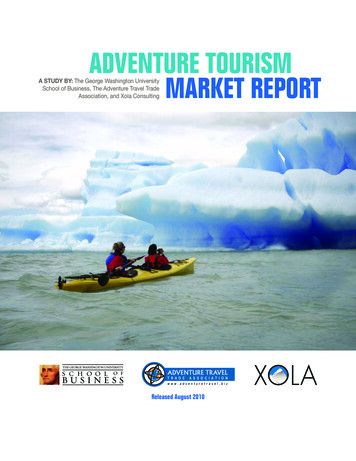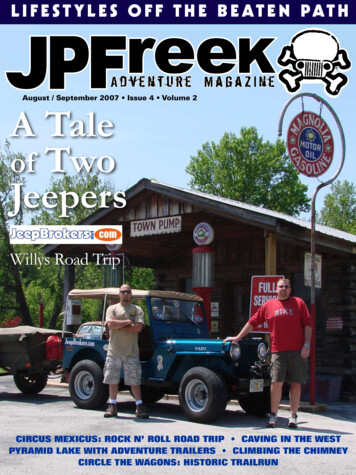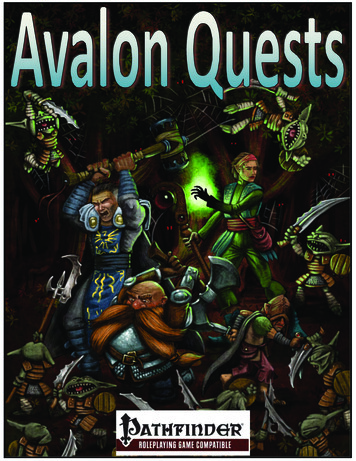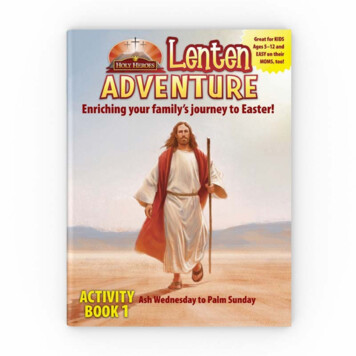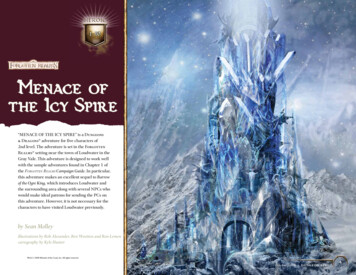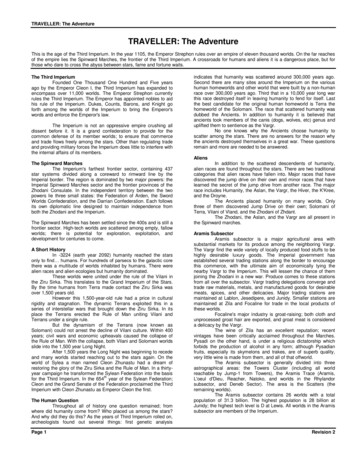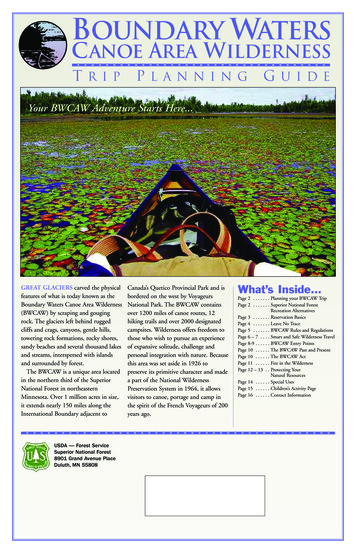
Transcription
BOUNDARY WATERSC ANOE AREA WILDERNESSTRIPPLANNINGGUIDEYour BWCAW Adventure Starts Here.GREAT GLACIERS carved the physicalfeatures of what is today known as theBoundary Waters Canoe Area Wilderness(BWCAW) by scraping and gougingrock. The glaciers left behind ruggedcliffs and crags, canyons, gentle hills,towering rock formations, rocky shores,sandy beaches and several thousand lakesand streams, interspersed with islandsand surrounded by forest.The BWCAW is a unique area locatedin the northern third of the SuperiorNational Forest in northeasternMinnesota. Over 1 million acres in size,it extends nearly 150 miles along theInternational Boundary adjacent toUSDA — Forest ServiceSuperior National Forest8901 Grand Avenue PlaceDuluth, MN 55808Canada’s Quetico Provincial Park and isbordered on the west by VoyageursNational Park. The BWCAW containsover 1200 miles of canoe routes, 12hiking trails and over 2000 designatedcampsites. Wilderness offers freedom tothose who wish to pursue an experienceof expansive solitude, challenge andpersonal integration with nature. Becausethis area was set aside in 1926 topreserve its primitive character and madea part of the National WildernessPreservation System in 1964, it allowsvisitors to canoe, portage and camp inthe spirit of the French Voyageurs of 200years ago.What’s Inside Page 2 . . . . . . . Planning your BWCAW TripPage 2 . . . . . . . Superior National ForestRecreation AlternativesPage 3 . . . . . . . Reservation BasicsPage 4 . . . . . . . Leave No TracePage 5 . . . . . . . BWCAW Rules and RegulationsPage 6 – 7 . . . . Smart and Safe Wilderness TravelPage 8-9 . . . . . . BWCAW Entry PointsPage 10 . . . . . . The BWCAW Past and PresentPage 10 . . . . . . The BWCAW ActPage 11 . . . . . . Fire in the WildernessPage 12 – 13 . . Protecting YourNatural ResourcesPage 14 . . . . . . Special UsesPage 15 . . . . . . Children’s Activity PagePage 16 . . . . . . Contact Information
Plan Your BWCAW Trip and Acceptthe Wilderness Challenge.Rkemember, successful wilderness trips don’tjust happen. They are the result of carefulplanning. Please use this trip planningguide to get started. However, wesuggest that you also use guidebooks and mapsthat can be found in bookstores, local libraries,and outdoor equipment stores. The expertise ofoutfitters and guides can also be used whenplanning a BWCAW trip.As you begin to plan your trip, ask yourselfabout the type of experience you seek. Would yourneeds for solitude or your quest for the elusive laketrout best be met inside the BWCAW portion ofthe Superior National Forest, or would camping inareas of the Forest adjacent to the BWCAW betterLeave a trip itinerarywith someone at home including: Trip leader’s name Entry point and datesuit the type of trip you want?The BWCAW is only one of many recreationalternatives on the Superior National Forest. Thisarea allows a visitor to enjoy the wilderness and allthat it has to offer. Wilderness recreationrequires careful planning and preparation andinvolves some risk. Wilderness travel offersgreat personal freedom, but also requires selfreliance and good judgement. Permits arerequired to enter the wilderness-. The visitor musthave knowledge of the entry points and routes;some research may be needed to gather thisinformation. These steps are necessary in order toprotect the BWCAW and to provide a qualitywilderness experience.Before You Leave HomeCheck current Minnesota Department ofNatural Resources fishing, hunting andboating regulations for:Consider specific survival gear to preventbecoming injured or lost in the wilderness such as: Canoe and boat registrations (Minnesotarequires all watercraft to be registered andhonors any state watercraft registrations)1. Extra food10. Fire starter2. Rain gear11. Water proof pouch Number of people in the group3. Warm clothing12. Nylon cord Fishing licenses and trout stamps4. Signaling mirror13. Folding knife Number of canoes or boats Fishing limits and possession of fish5. Whistle14. First aid kit Nearest Forest Service Ranger Stationand phone number Hunting seasons Exit point and date Potential route Name of outfitter (if applicable) Make of car(s) driven & licensenumber(s)The Forest Service does not automaticallyinitiate searches if a group doesn’t exit asplanned. If someone is concerned becauseyou are late returning from your trip, theyshould contact the County Sheriff ’s office(See Page 16 for emergency contact info).6. Emergency blanket Watercraft lights7. Maphttp://www.dnr.state.mn.usWilderness visitors face inherent risk of adverseweather conditions, isolation, physical hazards,and lack of rapid communications. Search andrescue may not be as swift as expected in anurban setting. Be prepared! Prevent the needfor a search and rescue operation that mayimpede the integrity of the wilderness area orput others in danger. Acquire and maintainnecessary skills for primitive travel by foot,canoe, or other non-mechanical means.You are responsible for your own safetyand that of your group.8. Compass9. Water filter orpurifierSuperior National Forest Recreation AlternativesIf something other than a wilderness trip is more your style, consider one of the following recreationalternatives in other beautiful areas of Superior National Forest. There are many ways to experience thegreat outdoors; explore what is best for you.BackcountryCampgroundsThere are a variety of options outside the BoundaryWaters Canoe Area Wilderness that can offer the samepeace and tranquility. In the Superior National Forest,there are over 200 sites outside the Wilderness called“backcountry”. These areas offer remote paddling,camping, and fishing. Here you can experiencesolitude without fees or permits, and still have a firegrate and latrine. These areas also have fewerregulations. Visitors to backcountry areas shouldfollow the LEAVE NO TRACE ethic. See Page 16 forcontact information.The Superior National Forest has 23 developedcampgrounds. Campgrounds are generally open frommid-May to mid-September; some are open all yearwith no water or garbage pickup off-season thoughwalk-in access may be required. Campgroundfacilities vary from flush toilets and showers to rusticcampgrounds with vault toilets and hand pumps.Each campsite has a picnic table, fireplace, tent padand parking spot. For a fee, reservations may bemade in advance at some of the campgroundsthrough the National Recreation Reservation System(NRRS) by calling 1-877-444-6777 or atwww.recreation.gov.Rustic. There are 17 rustic campgrounds with no fees.Water and garbage are not available.Commercial Resortsand CampgroundsWithin the Superior National Forest are a variety ofprivate resorts and campgrounds that may suit theneeds of a visitor looking for a trip near thewilderness rather than in it. Some of theseaccommodations are set up with showers, electricalhookups, and numerous other amenities. If thisdescribes your needs, you can get more information atthe chamber of commerce located nearest to the areayou would be visiting. See Page 8 for chamber ofcommerce and tourism contact information. Many ofthe chambers have web pages that may be accessed formore information.Additional information on campgrounds is available at www.fs.usda.gov/superior and www.recreation.govb o u n d a r yw a t e r s2c a n o ea r e aw i l d e r n e s s
The BasicsBWCAW Seasonal Fee CardWilderness PermitsPermits are required year-round for all day andovernight visitors to the Boundary Waters CanoeArea Wilderness. Please use the followinginformation to help you determine which type ofpermit is appropriate for your group.Quota PermitsAny group taking an overnight paddle, motor, orhiking trip, or a motorized day-use trip into theBWCAW from May 1 through September 30 isrequired to obtain a quota permit. The quotasystem regulates how many groups can begin atrip at each entry point each day. In addition tothe daily quotas, motorized boats are also limitedby a weekly motor quota. Groups may only enterthe BWCAW on the entry date and through theentry point specified on the permit. Permits mayonly be picked up the day before, or the day of,entry. Permits are not transferable. Reservationsare recommended since there are a limitednumber of quota permits available for each entrypoint. Quota permits can only be issued byForest Service issuing stations or by designatedCooperator issuing stations.Non-Quota Self-issuing PermitsSelf-issued permits are required year-round for allnon-motorized day use visitors, for anymotorized day use into Little Vermilion Lake,and for all overnight visitors entering theBWCAW between October 1 and April 30. Theself-issuing permit forms are available by mail, atany Superior National Forest office, and at themain BWCAW entry points. No reservation isrequired, but you will need to carefully follow theself-issuing instructions to fill out the permit.This includes reviewing the rules and regulationson the back of the permit with your entire group.Carry a copy of the permit with you at all timesand place a copy in the box at the entry point.The purchase of a BWCAW Seasonal Fee Cardfulfills the user fee requirements for the season,but does not eliminate the need for obtaining aBWCAW permit. For reserved permits it doesnot eliminate the need to pay the 6.00reservation fee and user fee deposit. They mayalso be purchased in person after May 1 from anyForest Service Permit Issuing Station.Seasonal Fee Card Costs PerPersonAdultYouth (0–17)Interagency Senior/Access Card HoldersYouth Access Card Holder 64.00 32.00 32.00 16.00Permit ReservationsFirst-Come, First-Served andLotteryWe will continue to make the reservation systeman efficient and effective system. For most of theBWCAW entry points, our data shows there arepermits available throughout the season.Therefore, it is not necessary to run a lottery forall entry points. A first-come, first-served systemwill be held at 9:00 am central time, the lastWednesday in January throughwww.recreation.gov or the reservation center at877-444-6777. Visitors will see available entrypoints and dates and make a reservation instantlyfor the permit that best meets their needs. Thisprovides immediate confirmation of theirreservation versus submitting multiple applicationsfor multiple dates in hopes of securing a BWCAWpermit via the lottery. A lottery may be retainedfor high-use entry points such as Fall and MooseLake. Please check our website regularly forupdates to the future of the lottery.Reservation FeeA 6.00 non-refundable reservation fee isrequired for each permit reserved.Special Use PermitsOvernight User Fee DepositOutfitters and guides leading groups into theBWCAW are required to obtain a specialuse permit. A listing of BWCAW Outfittersand Guides can be found atwww.fs.usda.gov/superior.When making advanced reservations, you will becharged a minimum of 2 adult overnight userfees. You will also have the option to pay for theentire group as well as changing the group sizewithin a one day window prior to your entrydate. If cancelled outside the 2-day window, thecard holder will be fully refunded. If cancelledwithin the 2-day window, 32.00 for 2 adults isretained and additional payments will berefunded. The Forest Service will retain the entirepayment if the group is a no show. A newconfirmation letter will be generated each time achange is made. Adjustments to group sizes willbe made at the permit issuing station as needed.User FeesUser fees are required for all overnight visitors tothe BWCAW between May 1 and September 30.There are no user fees for day use visitors.Fees are as follows:User Fees Per Person Per TripAdultYouth (0–17)Interagency Senior/Access Card HoldersYouth Access Card Holders 16.00 8.00 8.00 4.00Selecting a Permit IssuingStationmit when you make a reservation. You can select any issuingstation. The reservation systemdefaults to the Forest ServiceDistrict in which the entry pointlies. This default issuing station may be further from theentry point than anotherstation. For example,Moose River is within theLaCroix District(Cook) and wouldbe the default issuing station. MooseRiver is closer tothe KawishiwiDistrict (Ely). Pleasemake sure youreach the PermitIssuing Station chosen during their hours of operation.If you chose a Forest Service Office and are expecting delays on arrival, please change your issuing station to one with longer hours of operation. Youcan change your issuing station from a ForestService office to a cooperating business online or byphone up to the point of permit issuance.Picking Up A PermitPermits can only be picked up the day before orthe day of entry. Please check with your desiredpermit pick-up location to confirm their officehours. Remember to bring a photo ID when youpick up your permit.Reserved PermitsAll reserved permits must be picked up at thelocation specified in the reservation or at a ForestService issuing station. Only the group leader oralternate group leaders specified when thereservation was made can pick up the permit. Itis recommended that you list three alternateswhen you make your reservation — these cannotbe added at a later date. The person that picks upthe permit must be with the group for theduration of the trip. Any remaining overnightuser fees not paid prior to your trip will becalculated when the permit is issued based on thegroup size upon arrival.Non-Reserved PermitsNon-reserved quota permits can be picked up atany issuing station if the quota has not yet beenmet for the entry point you have selected.PaymentOnly Forest Service offices can accept cash andchecks, in addition to credit card payments. Alldiscount cards (Interagency Senior/Access, TreatyCard holders and BWCAW Seasonal Fee cards)must be presented at the time of permit pickup toreceive a discount, otherwise a full user fee will becharged. Non-Forest Service permit pick-uplocations may charge up to a 2.00 fee to issue anovernight permit.You must know where you will pick up your per-BWCAW Reservation InformationWEBSITEwww.recreation.govTDD (TOLL-FREE)(877) TDD-NRRSPHONE (TOLL-FREE)(877) 444-6777MAILING ADDRESSBWCAW Reservation CenterPO Box 462 Ballston Spa, NY 12020s u p e r i o r3FAX NUMBER(518) 884-9951INTERNATIONAL RESERVATIONS(518) 885-3639n a t i o n a lf o r e s t
Leave No Trace Principles“There are just two things on this material earth – people and natural resources” — Gifford PinchotThe Leave No Trace Principles of outdoor ethics form the framework of the Leave No Trace message andthe BWCAW Rules and Regulations:The Lakes Region is legendary in its richness andcomplexity. It exerts an ageless draw upon peoplewho seek adventure, refreshment and the exhilaration of outdoor recreation. But, as these wildlandshost more and more visitors, our collective markon the environment has become apparent — andmore damaging. Water pollution, litter, and disturbance to vegetation and soil, wildlife and otherrecreating visitors are indicators of the need toprotect these wild and serene waters and forests,and their inhabitants.There are far more of us pushing our outdooractivities to greater extremes and into the remotestparts of the natural world everyday. Our merepresence in wildlands has an influence.Destruction can be prevented if visitors are betterinformed, especially about low impact techniques.Together we can act on behalf of the places andwildlife that inspire us. To insure their continuedexistence, we must educate ourselves and adoptthe skills and ethics that enable us to Leave NoTrace. Please see the Lakes Region Leave No TraceSkills & Ethics Edition. For a copy of this publication and more information on how you canbecome LNT savvy, visit www.lnt.org.Plan Ahead and Prepare Know area rules and regulations Prepare for extreme weather Use a map and compass Reduce litter from the source — repackage foodinto reusable plastic bags or containers andremove excess packaging. Unwrap snack foods athome and bag them in bulk.Leave What You Find Don’t take cultural or historical artifacts orstructures Do not introduce or transport non-native plants,live bait or animals Leave rocks, plants and other natural objects asyou find themBe Considerate of Other Visitors Take breaks away from trails, portages andother visitors Let nature’s sounds prevail — avoid loudvoices and noises Don’t take campsites for day use, as this mayprevent someone from camping overnightPhoto courtesy of ETHAN KNUTI, Little Canada, MNTravel and Camp on Durable Surfaces Durable surfaces include established trails andcampsites, rock, gravel, dry grasses, or snow Keep campsites small – stay in area wherevegetation is absent Walk in single file in the middle of the trail evenwhen the trail is muddyMinimize Campfire Impacts Use a lightweight stove for cooking When fires are permitted, use an established firegrate and keep fires small Burn all wood and coals to ash, and make surethe fire is completely out Even after forest fires, you may see an amplesupply of burned wood near your site. Collectfirewood away from campsites to preventenlarging and defacing the areaDispose of Waste Properly Pack out all trash, leftover food, and litter Deposit human or dog waste in the latrines Wash yourself and dishes with biodegradable soapaway from streams or lakesRespect Wildlife Do not follow or approach wildlife Never feed animals. It can damage their healthand alters natural behaviors Protect wildlife and your food by storing rationsproperly Use lead free tackleYou can also do your part by viewing a 20 minute user education video aspart of your trip planning process. After viewing this video, BWCAWvisitors will understand how they can make a difference in the long-termhealth of the BWCAW by engaging in responsible recreation practices.This is an essential educational tool in protecting the fragile wildernessecosystem and providing a quality recreation experience for current andfuture generations. To obtain a copy of the BWCAW Leave No Trace UserEducation Video, please contact any Forest Service Office found on page16 of this publication.www.lnt.org Burning trash in firegrates pollutes and is illegalb o u n d a r yw a t e r s4c a n o ea r e aw i l d e r n e s s
BWCA Wilderness Rules & RegulationsThe following are enforceable Forest Serviceregulations (maximum penalty of 5,000 and/or6 months in jail).TRAVEL PERMITS You must enter the BWCAW at the entry pointand on the entry date shown on your permit. You may not re-enter on a different date usingthe same permit. Permit stubs become invalid when the trip leaderexits the wilderness. Due to the potential fire danger, firerestrictions may be put into effect. Checkon current conditions just prior to yourtrip. You may be required to use a campstove if there is a campfire restriction. If you build a fire, burn only smalldiameter dead wood found lying on theground. Do not burn trash. Collect firewood away from campsites bypaddling down the shore and walking intothe woods where it is more abundant. Wood easily broken by hand or cut with asmall folding saw eliminates the need foran axe.GROUP SIZE Nine (9) people and four (4) watercraft are themaximum allowed together in the wilderness. You may not exceed the limit at any time oranywhere (on water, portages, campsites) in theBWCAW. Drown your fire with water any time you aregoing to be away from your camp or at bedtime.Stir the ashes until they are cold to the touchwith a bare hand. Smaller groups increase your wildernessexperience and decrease the impacts. Transporting wood from out of state isprohibited.CAMPSITES It is illegal to cut live vegetation for any reason. You may camp up to fourteen (14) consecutivedays on a specific site.PORTAGE WHEELS Make camp early in the day to ensure finding anavailable campsite. Latrines are not garbage cans and should be usedfor the intended purpose only. Personal wasteitems such as cigarettes, cotton swabs, or plasticfeminine products should always be packed outand should never go into the latrines. If you’re not near a latrine, dig a small hole 6 to8 inches deep at least 150-200 feet or more backfrom the water’s edge. When finished, fill holeand cover with needles and leaves. Bathe and wash dishes at least 150-200 feet fromlakes and streams. All soaps pollute water including soaps labeled“biodegradable.”STORING WATERCRAFT Only watercraft and equipment used inconnection with your current visit may be storedand left unattended. All equipment and personal property must becarried out with you at the end of each trip.CULTURAL HERITAGE Leave archaeological, historical, and rock paintingsites undisturbed. The use of metal detectors is prohibited.FIREARMS & FIREWORKSCONTAINERS Cans and glass bottles are not allowed. Containers of fuel, insect repellent, medicines,personal toilet articles, and other items that arenot foods or beverages are the only cans andbottles you may keep in their original containers. Food may be packaged in plastic containers thatmust be packed out with you.FOOD, FISH REMAINS & LIVE BAIT Try to plan your meals so you don’t haveleftovers. If you do, pack them out. Discharging a firearm is prohibited within150 yards of a campsite, or occupied area,or in any manner or location that placespeople or property at risk of injury. State game laws apply in the BWCAW. Fireworks of any kind are illegal.PETS Dogs impact wildlife and barking intrudes on theexperience of others. They must be under controlat all times. Dispose of fecal matter 150 feet from watersources, campsites, and portages, or deposit it in alatrine. Dispose of fish remains by traveling well awayfrom campsites, trails, portages and shorelines.LEAVE NO TRACE OF YOUR VISIT When preparing for your trip, reduce litter at thesource by minimizing packaging. State law prohibits dumping unused bait intowaters of the state. Dumping bait on the groundis considered littering. Therefore, unwanted livebait should be packed out with you and placed inthe trash, disposal bins or compost bins.CAMPFIRES Fires are allowed within the steel fire grates atdesignated campsites or as specifically approvedon your visitor’s permit. Bringing a small camp stove may be a better ideabecause it heats food more quickly, has lessimpact than a fire, and comes in handy duringrainy weather.- Clearwater, North Fowl, South Fowl, Seagull (nomotors west of Three Mile Island), Sections ofIsland River within the BWCAW. On these lakes or portions of these lakes, thepossession of one additional motor no greaterthan 10 horsepower is permitted, as long asmotors in use do not exceed 25 horsepower:- Basswood (except that portion north ofJackfish Bay and Washington Island), Saganaga(except that portion west of American Point),Fall, Newton, Moose, Newfound, Sucker,Snowbank, East Bearskin, South Farm, Trout During ice free season, camp only at ForestService designated campsites that have steel firegrates and wilderness latrines. Use latrines at designated campsites.On these lakes, the possession of one additional motor nogreater than 6 horsepower is permitted, as long as motorsin use do not exceed 10 horsepower.LAKES WITH 25 HORSEPOWER LIMIT All members of a permit group must camptogether.TOILET FACILITIES & WATER QUALITYLAKES WITH 10 HORSEPOWER LIMIT After you break camp and load your watercraft,do a final inspection of your camp. Pick up anyremaining litter. Your fire must be cold to the touch. Please treat the BWCAW with care. Leave notrace of your visit to protect this special place forfuture generations.Mechanical assistance is only permitted overthe following: International Boundary, Four-MilePortage, Fall-Newton-Pipestone and Back BayPortages into Basswood Lake, Prairie Portage,Vermilion-Trout Lake Portage.LAKES WITH NO HORSEPOWER LIMITS- Little Vermilion, Loon, Lac La Croix (not beyondthe south end of Snow Bay in the U.S.A.), LoonRiver.HIKING While canoeing is the travel option for mostvisitors, the BWCAW is also host to severalhiking trails with opportunities ranging fromshort day hikes to multiple-day backpacking trips.No matter what length of hike you plan to take,hiking in the wilderness is not something youshould attempt without proper preparation, skillsand equipment. Wilderness trails vary in theirlevel of use and maintenance. Signage is minimalso it is a good idea to talk to someone at thenearest Ranger District Office for current trailconditions. There are a few restrictions that are slightlydifferent for those traveling by foot. Hikersshould use developed campsites along the trail orlake. Campsites along the trails are located onshort spur trails off the main trail and contain afire grate and wilderness latrine. Most campsitesare signed from the main trail with a tent symbol.If for some reason, (i.e. an approaching storm,full campsites, emergency, no developed campsitenearby) you must camp at a site other than adeveloped site, hikers may do so with thefollowing restrictions:- Trail users are encouraged to minimize impactby limiting use to one night on non-developedsites.MOTOR-POWERED WATERCRAFTREGULATIONS Motor-powered watercraft are permitted only onthe following designated lakes. All other lakes orportions of lakes within the BWCAW are paddleonly. Motors may not be used or be in possessionon any paddle-only lake. No other motorized ormechanized equipment (including pontoon boats,sailboats, sailboards) is allowed.s u p e r i o r5- You must camp more than 150-200 feet from adeveloped site or another group.- You must camp at least 150-200 feet from anytrail, portage, lake or other water source. Most importantly, be sure to use common senseand follow the safety guidelines recommended onPage 6-7. Wilderness permits are required yearround for hiking in the BWCAW. Happy Trails!n a t i o n a lf o r e s t
Smart & Safe Wilderness TravelWilderness travel offers great personal freedom, but also requires self-reliance and good judgment. Byusing common sense and following these important safety tips, you can have a safe BWCAW experience.LIFE JACKETS Always wear a lifejacket.FIRST AID ANDEMERGENCIES Each permittedgroup should carry awell stocked first aidkit and have groupmembers that knowhow to provide firstaid. Minnesota state law requires all watercraft,including canoes, to have one wearable U.S.Coast Guard-approved personal flotationdevice (PFD) on board and readilyaccessible for each person in the watercraft.MANDATORY CHILD LIFE JACKETWEAR LAW:Minnesota law requires a life jacket to beworn by children less than 10 years oldwhen aboard any watercraft while underway.For more on Minnesota state law, ex.htmlRAPIDS Generally, rapids in the BWCAW are not safeto “run”, so use the provided portages. Powerful currents can trap swimmers underwater, or sweep them towards dangerouswaterfalls. Fast moving water can push swimmers andboats into rocks and logs. Even with lifejackets on, rapids are dangerous.WATER QUALITY Giardia lambia is a parasite that can cause aninternal illness that will need medical attention. Please note that thecampsite number ispainted on thelatrine of mostcampsites. Also notethe location of thelake, campsite, trail orportage on a map to help emergency peoplelocate any seriously injured party. Document the extent of the injuryand a basic physical descriptionof the injured person. Send all of thisinformation withvisitors able to exit theBWCAW for help. For summoning help from an aircraft in anemergency, signal them by paddling in smallcircles or waving a brightly colored cloth tied tothe canoe paddle.TRAVEL There are no directional signs inwilderness. A compass and accurate mapare essential. Early warning signs are uncontrolled shivering,slurred speech, bluish tinge to lips, lack ofcoordination, and poor concentration. To prevent hypothermia, layer clothing and getadequate food and water. To treat hypothermia, seek shelter from thewind, replace any wet clothing, and share bodyheat if necessary. Give warm fluids if the person is consciousand have them rest until thoroughly warmed.b o u n d a r y Avoid being a bridge between an object andthe ground. For example, do not lean againsttent poles or trees. Avoid potential paths of conduction such aswet, lichen-covered rocks, cracks and crevices(wet or dry), and areas subject to the “spark gap”such as overhangs, wet ropes, and tree roots. If your skin tingles, or your hair stands onend, stand on a lifejacket or sleepingbag, squat low to the ground on theballs of your feet.DEHYDRATION The body becomesdehydrated whenmore fluids arelost than replaced.FISH Chemicals such as mercury, PCBs, and dioxinhave been found in some fish fromcertain waters.HYPOTHERMIA A low body temperature can beserious, even fatal. If in a lightning storm on the water, get toshore. If on land among trees of similar height,put yourself an equivalent distance between twotrees. Avoid the tallest trees. Do not rely on a cellphone. Having a cellphone cannot substitutefor knowing how tohandle an emergency inwilderness. Many areas ofthe BWCAW lack cellphone coverage. In the event of serious injuryor illness, the standard SOS call is aseries of three signals of any kind, either audibleor visible. Check with theMinnesotaDepartment of PublicHealth for currentinformation on limitson fish consumption at(651) 201-4911. Dress in layers and be prepared for every kindof weather situation. Place your hands on your knees withyour head between them. Makeyourself the smallest target possible,and minimize your contact withthe ground. All drinking water should be treated by one ofthe following methods: 1. Bring water to a fullboil for 3 to 5 minutes — then let stand untilcool enough to drink. 2. Purify with a filterspecifically designed to remove Giardia lambia.3. Treat water with a chemical specificallydesigned to kill Giardia lambia. Eat more pan fish andfewer predator fish andtrim the skin and fat,to reduce your risk.WEATHER Canoe close
Your BWCAW Adventure Starts Here. GREAT GLACIERS carved the physical . Extra food 2. Rain gear 3. Warm clothing 4. Signaling mirror 5. Whistle 6. . First aid kit. superior 3 national forest BWCAW Reservation Information WEBSITE PHONE (TOLL-FREE) FAX NUMBER www.recreation.gov (877) 444-6777 (518) 884-9951 TDD (TOLL-FREE) MAILING ADDRESS .


